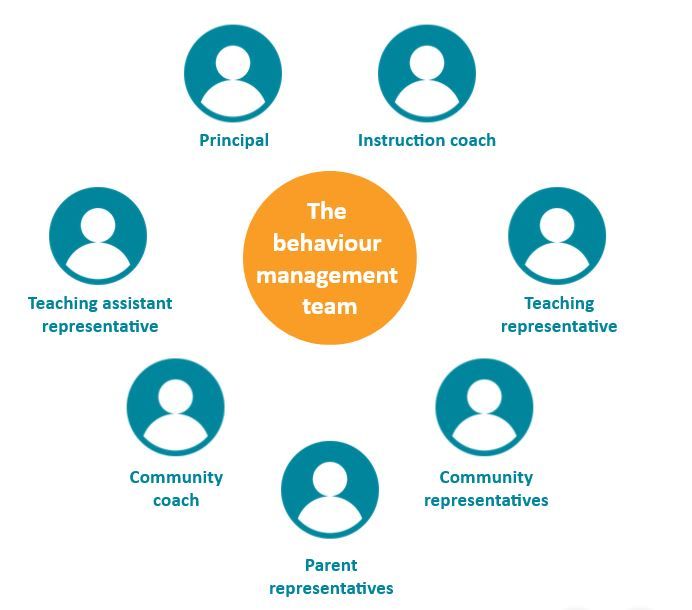Build Positive High-Expectations School Communities
-
Module Introduction5 Topics
-
Purpose and Rationale17 Topics|2 Tests
-
Cover
-
Lesson Objective
-
Opening the Lesson
-
Building Positive High-expectations School Communities
-
Behaviour Management and Effective Teaching
-
Using Effective Behaviour Management Strategies in a Positive High-expectations Classroom
-
Parents and Effective Behaviour Support
-
Teach Behaviour Expectations
-
Implement Effective Practices
-
Leading Values and Behaviours
-
School Vision
-
School Mission
-
Vision and Mission
-
Check your understanding
-
Test your understanding
-
Review
-
Lesson Completed
-
Cover
-
A Team Approach to Behaviour Management13 Topics|2 Tests
-
Building School-Wide Capacity17 Topics|2 Tests
-
Cover
-
Lesson Objective
-
Opening the Lesson
-
Positive High-expectations Behaviour
-
Prevent and Support
-
Positive Behaviour Intervention and Support (PBIS) Features
-
Three Behaviour Support Levels
-
Identifying and Teaching Expectations
-
Approach to Social-Emotional Learning
-
Effective Practices and Team Problem-solving
-
Data to Identify Problems and Monitor Progress
-
Culturally and Contextually Relevant
-
Factors of Successful School Behaviour Models
-
Check your understanding
-
Test your understanding
-
Review
-
Lesson Completed
-
Cover
-
Teaching Expectations and Character Strengths14 Topics|2 Tests
-
Cover
-
Lesson Objective
-
Opening the Lesson
-
School-wide Expectations
-
Values and Shared Expectations
-
Values Cultivate Positive Behaviour
-
Values Cultivate Positive Behaviour
-
Character Strengths
-
Developing Character Strengths School-wide
-
Teaching Values, Expectations and Character Strengths
-
Check your understanding
-
Test your understanding
-
Review
-
Lesson Completed
-
Cover
-
Teaching Rules and Routines15 Topics|2 Tests
-
Cover
-
Lesson Objective
-
Opening the Lesson
-
Established School-wide Domains
-
Clarify Expectations
-
Teach Expectations
-
Teaching Routines
-
Explicit Direct Instruction Model
-
Effective Teaching of Rules and Routines
-
Effective Teaching Components
-
Integrating Routines
-
Check your understanding
-
Test your understanding
-
Review
-
Lesson Completed
-
Cover
-
Principles of Reinforcement15 Topics|2 Tests
-
Cover
-
Lesson Objective
-
Opening the Lesson
-
Consequences
-
Positive and Negative Reinforcement
-
Use Positive Reinforcement to Acknowledge Positive Student Behaviour
-
Punishment and Discipline
-
Shaping Behaviour
-
Continuum of Reinforcement
-
Misconceptions about Reinforcement
-
What Reinforcement Is and Is Not
-
Check your understanding
-
Test your understanding
-
Review
-
Lesson Completed
-
Cover
-
School-Wide Systems for Shaping Behaviour14 Topics|2 Tests
-
Cover
-
Lesson Objective
-
Opening the Lesson
-
Promoting Positive Behaviour
-
Strengthening Expected Behaviours
-
Reinforcing Character Strengths
-
Feedback and Reinforcement
-
Reinforcement Strategies
-
Effective Teaching and Behaviour
-
Active Supervison
-
Check your understanding
-
Test your understanding
-
Review
-
Lesson Completed
-
Cover
-
Motivation for Misbehaviour15 Topics|2 Tests
-
Cover
-
Lesson Objective
-
Opening the Lesson
-
Defining Behaviour
-
Behaviour as Communication
-
Motivation to Approach or Avoid
-
Correcting Behavioural Errors
-
Mentoring Intervention
-
Defining Levels of Problem Behaviour
-
Effective Teaching Reduces Misbehaviour
-
How you use the information you find to decrease the misbehaviour
-
Check your understanding
-
Test your understanding
-
Review
-
Lesson Completed
-
Cover
-
Continuum and Hierarchy of Consequences16 Topics|2 Tests
-
Cover
-
Lesson Objective
-
Opening the Lesson
-
System of Consequences
-
Standard Response to Behaviour Errors
-
Teacher-managed Behaviour
-
Positive Verbal Responses
-
In-class Strategies
-
Office-managed Behaviour
-
School-wide Strategies
-
A Successful System of Consequences and Responding to Minor/major Behaviour Challenges
-
Choosing from the Continuum
-
Check your understanding
-
Test your understanding
-
Review
-
Lesson Completed
-
Cover
-
Collecting Data for Decision Making13 Topics|2 Tests
-
Team Problem-Solving14 Topics|2 Tests
-
Engaging Parent, Families and Communities15 Topics|2 Tests
-
Cover
-
Lesson Objective
-
Opening the Lesson
-
Importance of Partnerships
-
Developing a Partnership
-
Strengthening Partnerships with Families
-
Engaging Parents
-
Influencing Conversation: Example One
-
Influencing Conversation: Example Two
-
Basic Messages
-
Holding an Influencing Conversation with Parents
-
Check your understanding
-
Test your understanding
-
Review
-
Lesson Completed
-
Cover
-
Module evaluation survey1 Topic
Participants 724
The Behaviour Management Team
ddewell@goodtogreatschools.org.au August 8, 2023

The Behaviour Management Team
The Behaviour Management Team manages the implementation of the positive high-expectations behaviour plan. In large schools the team comprises of the principal, instruction coach, community coach, and representatives of teachers, teaching assistants, parents and community. In a small school, the whole school team might work with parent and community representatives to manage the implementation of the plan.

The Behaviour Management Team meets weekly to review the implementation of the behaviour plan. They raise issues and discuss implementation areas. They review data to identify concerns and problem-solve. Prior solutions are evaluated for effectiveness using data.
The team uses data to identify individual students in need of more intensive supports. They make sure that students involved in the check-in, check-out program have a teacher with whom to connect. For students requiring a behaviour improvement plan, the team requests expert support and follow up to make sure the plan is being implemented.

